Performance Optimization Strategies for Polymer Organic Field-Effect Transistors as Sensing Platforms
Abstract
1. Introduction
2. Strategies for Performance Improvement
2.1. Annealing
2.2. Solvent Engineering
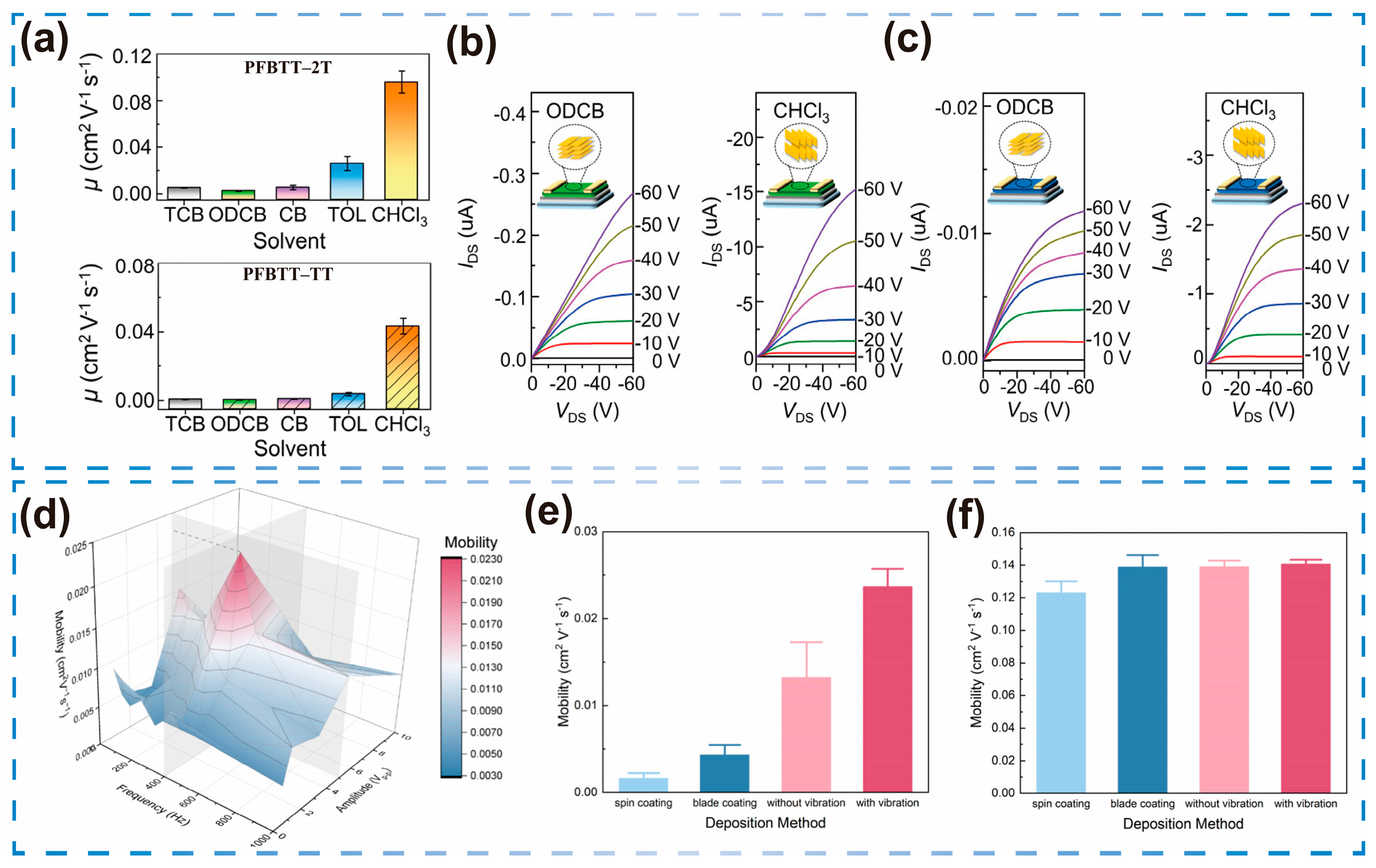
2.3. Self-Assembled Monolayers
2.4. Buffer-Layer Insertion
2.5. Dielectric-Layer Engineering
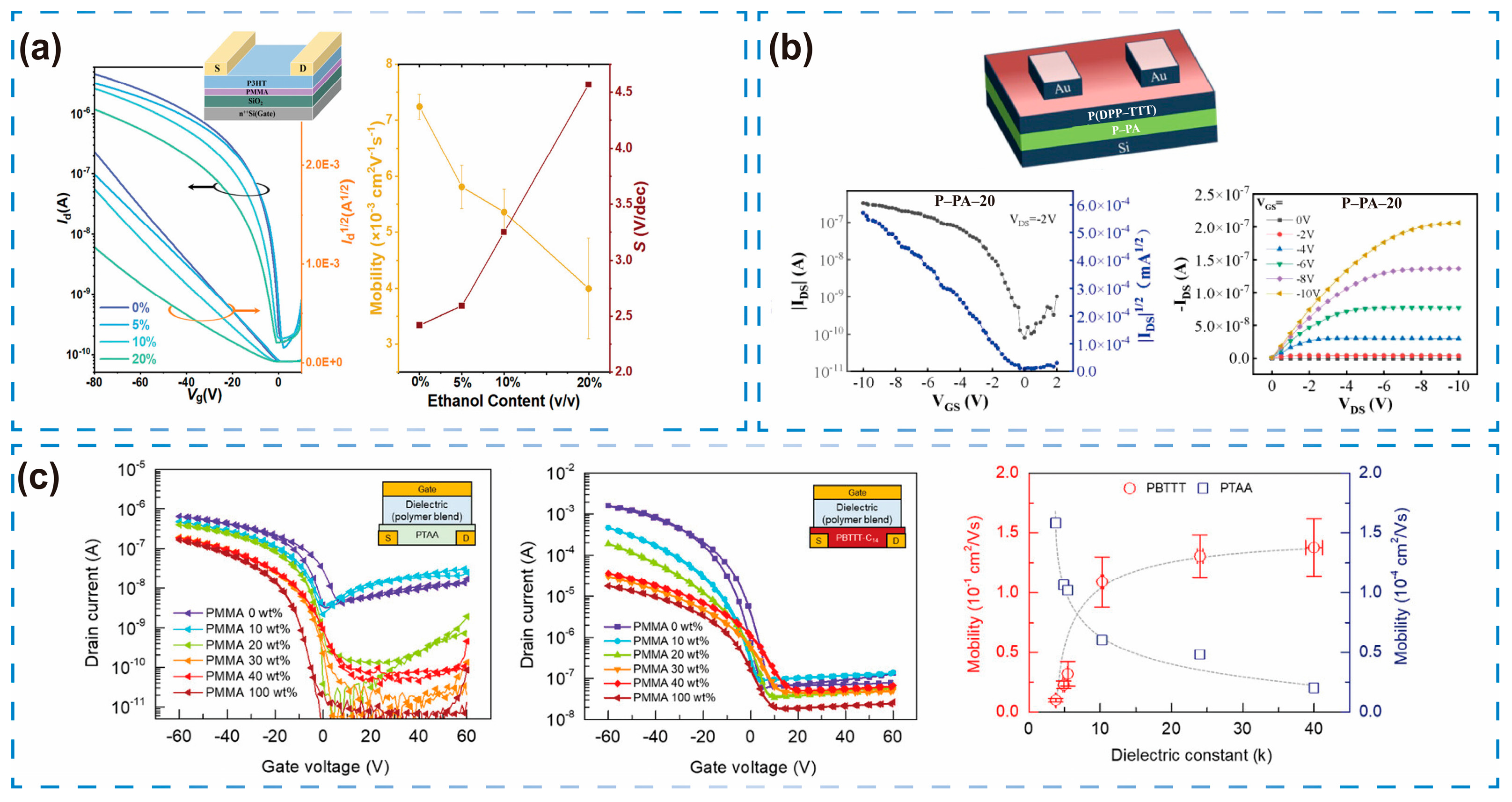
2.6. Main-Chain Engineering
2.7. Side-Chain Engineering
2.8. Blending and Doping
3. Application of Performance Optimization Strategies in Sensor Platforms
3.1. Enhancing Sensitivity and Lowering Detection Limit
3.2. Improving Selectivity and Specificity
3.3. Enhancing Stability and Reproducibility
4. Discussion and Future Directions
Author Contributions
Funding
Data availability statement
Conflicts of Interest
References
- Horowitz, G. Organic field effect transistors. Adv. Mater. 1998, 10, 365–377. [Google Scholar] [CrossRef]
- Surya, S.G.; Raval, H.N.; Ahmad, R.; Sonar, P.; Salama, K.N.; Rao, V.R. Organic field effect transistors (OFETs) in environmental sensing and health monitoring: A review. Trends Anal. Chem. 2019, 111, 27–36. [Google Scholar] [CrossRef]
- Chao, L.; Liang, Y.; Hu, X.; Shi, H.; Xia, T.; Zhang, H.; Xia, H. Recent advances in field effect transistor biosensor technology for cancer detection: A mini review. J. Phys. D Appl. Phys. 2022, 55, 153001. [Google Scholar] [CrossRef]
- Cheng, S.; Wang, Y.; Zhang, R.; Wang, H.; Sun, C.; Wang, T. Recent progress in gas sensors based on P3HT polymer field-effect transistors. Sensors 2023, 23, 8309. [Google Scholar] [CrossRef] [PubMed]
- Zhang, C.C.; Chen, P.L.; Hu, W.P. Organic field-effect transistor-based gas sensors. Chem. Soc. Rev. 2015, 44, 2087–2107. [Google Scholar] [CrossRef] [PubMed]
- Yamashita, Y. Organic semiconductors for organic field-effect transistors. Sci. Technol. Adv. Mater. 2009, 10, 024313. [Google Scholar] [CrossRef] [PubMed]
- Luo, L.; Liu, Z.T. Liu. Recent progress in organic field-effect transistor-based chem/bio-sensors. View 2022, 3, 20200115. [Google Scholar] [CrossRef]
- Fratini, S.; Nikolka, M.; Salleo, A.; Schweicher, G.; Sirringhaus, H. Charge transport in high-mobility conjugated polymers and molecular semiconductors. Nat. Mater. 2020, 19, 491–502. [Google Scholar] [CrossRef]
- Kranthiraja, K.; He, W.E.; Yu, H.W.; Feng, Z.; Nozaki, N.; Matsumoto, H.; Yu, M.H.; Li, Y.; Manzhos, S.; Andersson, M.R.; et al. Diketopyrrolopyrrole-dioxo-benzodithiophene-based multifunctional conjugated polymers for organic field-effect transistors and perovskite solar cells. Sol. RRL 2024, 8, 2400185. [Google Scholar] [CrossRef]
- Liu, C.C.; Shao, L.; Chen, S.H.; Hu, Z.W.; Cai, H.J.; Huang, F. Recent progress in π-conjugated polymers for organic photovoltaics: Solar cells and photodetectors. Prog. Polym. Sci. 2023, 143, 101711. [Google Scholar] [CrossRef]
- Warr, D.A.; Perdigao, L.M.A.; Pinfold, H.; Blohm, J.; Stringer, D.; Leventis, A.; Bronstein, H.; Troisi, A.; Costantini, G. Sequencing conjugated polymers by eye. Sci. Adv. 2018, 4, eaas9543. [Google Scholar] [CrossRef]
- Ghosh, R.; Paesani, F. Unraveling the effect of defects, domain size, and chemical doping on photophysics and charge transport in covalent organic frameworks. Chem. Sci. 2021, 12, 8373–8384. [Google Scholar] [CrossRef] [PubMed]
- Chen, H.; Zhang, W.; Li, M.; He, G.; Guo, X. Interface engineering in organic field-effect transistors: Principles, applications, and perspectives. Chem. Rev. 2020, 120, 2879–2949. [Google Scholar] [CrossRef]
- Choi, H.H.; Yi, H.T.; Tsurumi, J.; Kim, J.J.; Briseno, A.L.; Watanabe, S.; Takeya, J.; Cho, K.; Podzorov, V. A large anisotropic enhancement of the charge carrier mobility of flexible organic transistors with strain: A Hall effect and Raman study. Adv. Sci. 2020, 7, 1901824. [Google Scholar] [CrossRef]
- Mandal, A.; Mallik, S.; Mondal, S.; Subhadarshini, S.; Sadhukhan, R.; Ghoshal, T.; Mitra, S.; Manna, M.; Mandal, S.; Goswami, D.K. Diffusion-Induced Ingress of Angiotensin-Converting Enzyme 2 into the Charge Conducting Path of a Pentacene Channel for Efficient Detection of SARS-CoV-2 in Saliva Samples. ACS Sens. 2022, 7, 3006–3013. [Google Scholar] [CrossRef]
- Hao, R.S.; Liu, L.; Yuan, J.Y.; Wu, L.L.; Lei, S.B. Recent Advances in Field Effect Transistor Biosensors: Designing Strategies and Applications for Sensitive Assay. Biosensors 2023, 13, 426. [Google Scholar] [CrossRef]
- Zhang, X.; Pu, Z.; Su, X.; Li, C.; Zheng, H.; Li, D. Flexible organic field-effect transistors-based biosensors: Progress and perspectives. Anal. Bioanal. Chem. 2023, 415, 1607–1625. [Google Scholar] [CrossRef]
- Thakur, Y.; Khosla, M.; Raj, B.; Bala, S.; Raj, B. Process parameters variation effect on OFET based low power hydrogen sensor design. Optoelectron. Adv. Mater. 2024, 18, 555–561. [Google Scholar]
- Raval, H.N.; Rao, V.R. Low-operating-voltage operation and improvement in sensitivity with passivated OFET sensors for determining total dose radiation. IEEE Electron Device Lett. 2010, 31, 1482–1484. [Google Scholar] [CrossRef]
- Chen, J.X.; Dong, Z.X.; Wang, Q.; Han, Z.J.; Sun, H.F.; Li, Y.Z.; Wu, Y.; Zhan, X.Z.; Zhu, T.; Endoh, M.; et al. Impact of Irreversible Adsorption on Molecular Ordering and Charge Transport in Poly(3-hexylthiophene) Thin Films on Solid Substrates. ACS Appl. Mater. Interfaces 2024, 16, 56325–56335. [Google Scholar] [CrossRef] [PubMed]
- Zohaib, M.; Afzal, T.; Zahir Iqbal, M.; Almutairi, B.S.; Ali Raza, M.; Maqsood, M.F.; Raza, M.A.; Riaz, S.; Naseem, S.; Iqbal, M.J. Role of time-dependent foreign molecules bonding in the degradation mechanism of polymer field-effect transistors in ambient conditions. R. Soc. Open Sci. 2023, 10, 221272. [Google Scholar] [CrossRef] [PubMed]
- Yi, S.T.; Zheng, H.; Peng, J. Synergistic backbone and side chain engineering on crystalline orientation and charge transport of conjugated polymers in field-effect transistors. Polymer 2025, 327, 128391. [Google Scholar] [CrossRef]
- Sabury, S.; Xu, Z.; Saiev, S.; Davies, D.; Österholm, A.M.; Rinehart, J.M.; Mirhosseini, M.; Tong, B.; Kim, S.; Correa-Baena, J.P.; et al. Non-covalent planarizing interactions yield highly ordered and thermotropic liquid crystalline conjugated polymers. Mater. Horiz. 2024, 11, 3352–3363. [Google Scholar] [CrossRef] [PubMed]
- Tran, D.K.; Kim, F.S.; Jenekhe, S.A. n-Channel polymer field-effect transistors without encapsulation have over 21-year stability in ambient air. ACS Mater. Lett. 2025, 7, 3049–3057. [Google Scholar] [CrossRef]
- Luo, X.B.; Li, L.X.; Li, D.K.; Zhao, Q.Q.; Zhan, H.; Dong, Y.J.; Han, Y.C.; Peng, J. Effect of solution-state aggregation on solid-state crystal orientation in donor-acceptor conjugated copolymers. Chem. Mater. 2024, 36, 3726–3734. [Google Scholar] [CrossRef]
- Wu, X.C.; Chen, S.Y.; Jiang, L.L.; Wang, X.H.; Qiu, L.Z.; Zheng, L. Highly sensitive, low-energy-consumption biomimetic olfactory synaptic transistors based on the aggregation of the semiconductor films. ACS Sens. 2024, 9, 2673–2683. [Google Scholar] [CrossRef]
- Sun, M.T.; Sun, Z.Y.; Zheng, Y.L.; Kim, R.; Liu, A.L.; Richter, L.J.; Gilchrist, J.F.; Reichmanis, E. Preprocessing affords 3D crystalline poly(3-hexylthiophene) structure. Chem. Mater. 2025, 37, 2795–2805. [Google Scholar] [CrossRef]
- Jiang, X.; Zeng, J.Q.; Zhang, L.X.; Zhang, Z.; Zhu, R.J. Binary solvent engineering modulates the microstructure of stretchable organic field-effect transistors for highly sensitive NO2 sensing. Nanomaterials 2025, 15, 922. [Google Scholar] [CrossRef]
- Sangwan, S.K.; Shaharukh, S.; Ray, S.K.; Dhar, A. Modulating poly(methyl methacrylate) gate dielectric behavior with cosolvent and low-temperature processing for low-threshold-voltage flexible organic field-effect transistors. ACS Appl. Electron. Mater. 2024, 7, 560–570. [Google Scholar] [CrossRef]
- Lin, J.Y.; Hsu, F.C.; Chao, Y.C.; Ho, C.C.; Lai, M.C.; Li, T.Y.; Chen, Y.F. High-performance organic field-effect transistors based on a self-assembled polar dielectric monolayer. ACS Appl. Electron. Mater. 2025, 7, 2602–2609. [Google Scholar] [CrossRef]
- Mandal, B.; Sonar, P.; Singh, S.P. Visible light-stimulated artificial synapse based on an organic field-effect transistor for imitating human emotions and mood swings. ACS Appl. Electron. Mater. 2024, 6, 2420–2433. [Google Scholar] [CrossRef]
- Purabiarao, N.H.; Gaurav, K.V.; Sharma, S.; Ando, Y.; Pandey, S.S. Implication of surface passivation on the in-plane charge transport in the oriented thin films of P3HT. Electron. Mater. 2025, 6, 6. [Google Scholar] [CrossRef]
- Baranwal, R.; Tripathi, A.S.M.; Chatterjee, A.; Sen, U.; Singh, P.; Mishra, V.N.; Verma, S. Fabrication and characterization of PDPP2T-TT thin film FET-based NH3 gas sensor at room temperature. Opt. Mater. 2025, 166, 117174. [Google Scholar] [CrossRef]
- Ramer, S.G.; Gaurav, K.V.; Palani, I.A.; Ando, Y.; Pandey, S.S.; Singh, V. Boosting the performance of organic phototransistors utilizing oriented thin-films of liquid crystalline conjugated polymer PBTTT C-14. Phys. Status Solidi (RRL) Rapid Res. Lett. 2025, 2500011. [Google Scholar] [CrossRef]
- Luukkonen, A.; Jern, J.; He, Q.; Heeney, M.; Oesterbacka, R. Reversible stress-induced doping and charge trap generation in IDT-BT EGOFETs. J. Mater. Chem. C 2025, 13, 3815–3824. [Google Scholar] [CrossRef]
- Waldrip, M.; Yu, Y.; Dremann, D.; Losi, T.; Willner, B.; Caironi, M.; McCulloch, I.; Jurchescu, O.D. Designing contact independent high-performance low-cost flexible electronics. Adv. Mater. 2024, 36, 2410442. [Google Scholar] [CrossRef]
- Anh, K.D.; dos Santos, P.L.; Saeed, M.; Chaudhry, M.U.; Bechtold, I.H.; Batycki, A.; Drewniak, A.; Szlapa-Kula, A.; Ledwon, P. The role of fused thiophene and naphthalene diimide (NDI) in shaping the optical and electrical properties of donor-acceptor polymers. Org. Electron. 2024, 129, 107058. [Google Scholar] [CrossRef]
- Wang, X.Y.; Yin, Z.G.; Liu, C.D.; Liu, Y.T.; Ma, Y.L.; Zheng, Q.D. Low-voltage flexible organic transistors utilizing passivated polyelectrolyte dielectrics for tactile sensing and braille recognition. J. Colloid. Interf. Sci. 2025, 691, 137417. [Google Scholar] [CrossRef]
- Wu, M.; Chen, C.L.; Li, F.M.; Zhang, S.; Wang, H.Y.; Liu, J.; Huang, Y.A.; Gao, S.H.; Wei, D.C.; Jiang, L. All solution-processed organic field-effect transistors with low contact resistance via interface engineering for high-performance flexible circuits. Sci. China Mater. 2025, 68, 2246–2255. [Google Scholar] [CrossRef]
- Sun, Q.; Hu, J.K.; Chen, C.; Wan, X.B.; Mu, Y.B. Functional zwitterionic polyurethanes as gate dielectrics for organic field-effect transistors. Adv. Electron. Mater. 2025, 11, 2400578. [Google Scholar] [CrossRef]
- Jang, S.C.; Lee, G.; Park, I.; Noh, B.; Park, J.-M.; Lee, J.; Lee, K.J.; Kim, H.-S. Tunable dielectric properties of a parylene dielectric layer through surface-modulation by click chemistry. J. Mater. Chem. C 2025, 13, 6614–6623. [Google Scholar] [CrossRef]
- Tavasli, A.; Majewski, L.A.; Uddin, M.A.; Gomez-Lor, B.; Trabzon, L.; Faraji, S. Designing ZrO2-blended nanocomposite MIM capacitors for future OFET applications and their characterizations. Mater. Sci. Semicond. Proc. 2025, 188, 109180. [Google Scholar] [CrossRef]
- Hu, J.K.; Sun, M.Q.; Wei, T.L.; Chen, C.; Wan, X.B.; Mu, Y.B. Low-voltage organic field-effect transistors using a phosphocholine-based polyampholyte dielectric. Macromolecules 2025, 58, 5618–5626. [Google Scholar] [CrossRef]
- Yang, Y.H.; Shen, H.Q.; Ge, S.S.; Yao, Z.Y.; Zuo, B. Distribution of density of states in organic field-effect transistors based on polymer dielectrics. Adv. Mater. Interfaces 2024, 11, 2400239. [Google Scholar] [CrossRef]
- Ortiz, R.P.; Facchetti, A.; Marks, T.J. High-k organic, inorganic, and hybrid dielectrics for low-voltage organic field-effect transistors. Chem. Rev. 2010, 110, 205–239. [Google Scholar] [CrossRef] [PubMed]
- Park, H.; Yoo, S.; Ha, J.; Kim, J.; Mun, H.J.; Shin, T.J.; Won, J.C.; Kim, Y.H. Tailored polymer gate dielectric engineering to optimize flexible organic field-effect transistors and complementary integrated circuits. ACS Appl. Mater. Interfaces 2021, 13, 30921–30929. [Google Scholar] [CrossRef]
- Bond, C.R.; Katz, H.E.; Frydrych, D.J.; Rose, D.B.G.; Miranda, D. Polymeric semiconductor in field-effect transistors utilizing flexible and high-surface area expanded poly(tetrafluoroethylene) membrane gate dielectrics. ACS Appl. Mater. Interfaces 2024, 16, 12873–12885. [Google Scholar] [CrossRef]
- Jeong, B.; Asadi, K. Resolving the high-k paradox in organic field-effect transistors through rational dielectric design. Adv. Electron. Mater. 2025, 11, 2500040. [Google Scholar] [CrossRef]
- Sasaki, Y.; Ohshiro, K.; Kato, M.; Haba, D.; Nakagami, G.; Minami, T. Detection of micromolar glucose levels in human sweat using an organic transistor-based enzymatic sensor. Chemelectrochem 2024, 11, e202400292. [Google Scholar] [CrossRef]
- Nketia-Yawson, V.; Nketia-Yawson, B.; Jo, J.W. Performance enhancement of aluminium-gated poly (3-hexylthiophene) transistors with polymer electrolyte/PMMA bilayer gate dielectrics. Polymer 2024, 293, 126660. [Google Scholar] [CrossRef]
- Son, Y.; Kim, T.; Kim, H.; Kim, Y. Pronounced light insensitivity in low-voltage n-channel organic field-effect transistors with channel layers of dinitrobenzothiadiazole-containing conjugated polymer. ACS Appl. Electron. Mater. 2024, 7, 64–72. [Google Scholar] [CrossRef]
- Boukhili, W.; Wageh, S.; Wan, X.; Yu, Z.; Tan, C.L.; Sun, H.; Noh, Y.-Y.; Baeg, K.-J.; Xu, Y.; Khim, D. Effects of high capacitance of solution-processed polymer heterojunction gate dielectrics on the contact resistance of low-voltage n-channel organic transistors. Org. Electron. 2025, 138, 107191. [Google Scholar] [CrossRef]
- Makala, M.; Barlóg, M.; Dremann, D.; Attar, S.; Fernández, E.G.; Al-Hashimi, M.; Jurchescu, O.D. High-performance n-type polymer field-effect transistors with exceptional stability. J. Mater. Chem. C 2024, 12, 17089–17098. [Google Scholar] [CrossRef]
- Li, Q.; Li, X.W.; Ding, L.F.; Li, Y.W.; Ma, J.N.; Sang, S.B.; Minami, T. Organic photodetectors achieving UV-visible broadband detection via P3HT-OFET epitaxial integration. ACS Appl. Electron. Mater. 2025, 7, 6166–6176. [Google Scholar] [CrossRef]
- Shi, W.; Chen, S.; Yan, X.L.; Lin, Z.H.; Liu, Z.L.; Liu, L. High-performance stretchable organic field-effect transistor fabricated with an ionic-gel dielectric. ACS Appl. Polym. Mater. 2024, 6, 13290–13299. [Google Scholar] [CrossRef]
- Zhang, X.Y.; Li, X.X.; Wang, W.Y.; Jiang, H.C.; Zheng, X.R.; Yang, H.Q.; Ye, X.; Yang, H. Low-voltage and stretchable organic field effect transistor array based on tri-layer elastomer dielectric for gas sensing. Adv. Electron. Mater. 2025, 11, 2400981. [Google Scholar] [CrossRef]
- Yu, X.; Guo, J.H.; Wang, C.; Zhang, K.K.; Wang, H.Z.; Ma, S.Y.; Zhang, H.C. Self-assembled Quinacridone (QA) based polymers with strong hydrogen bonding for OFETs. Dyes Pigments 2024, 227, 112157. [Google Scholar] [CrossRef]
- Gao, K.; Wang, C.; Liu, K.K.; Zhang, H.C. Cyano substituted stilbene-based polymers for OFETs: From p-type to n-type. Dyes Pigments 2025, 236, 112685. [Google Scholar] [CrossRef]
- Erhardt, A.; Hungenberg, J.; Chantler, P.; Kuhn, M.; Huynh, T.T.; Hochgesang, A.; Goel, M.; Mueller, C.J.; Roychoudhury, S.; Thomsen, L.; et al. Design principles of diketopyrrolopyrrole-thienopyrrolodione acceptor1-acceptor2 copolymers. Adv. Funct. Mater. 2024, 34, 2314696. [Google Scholar] [CrossRef]
- Chen, Z.; Zhang, Z.; Sun, Q.; Jia, Q.; Wang, Z.; Zhang, K.; Wang, C.; Jiang, J.; Cao, L.; Tang, J. Enhancing n-Type Charge Transport in Organic Transistors: Cyano-Functionalized thienylene-vinylene-thienylene (TVT) Polymers. Dyes Pigments 2025, 245, 113266. [Google Scholar] [CrossRef]
- Kim, J.; Ren, X.; Zhang, Y.; Fazzi, D.; Manikandan, S.; Andreasen, J.W.; Sun, X.; Ursel, S.; Un, H.I.; Peralta, S. Efficient N-Type Organic Electrochemical Transistors and Field-Effect Transistors Based on PNDI-Copolymers Bearing Fluorinated Selenophene-Vinylene-Selenophenes. Adv. Sci. 2023, 10, 2303837. [Google Scholar] [CrossRef] [PubMed]
- Alam, S.; Li, M.Q.; Yang, S.; Lee, J. Boosting the performance of polymer field-effect transistors through fluorine atom substitutions and comparing the effect of various acceptor units and channel mobilities. Org. Electron. 2024, 130, 107069. [Google Scholar] [CrossRef]
- Zhang, S.; Liu, Y.; Dong, H.; Li, Y.; Zhang, K.; Xian, K.; Han, Y.; Ye, L.; Heeney, M.; Fei, Z. Isomeric 1,4-dihydropentalene-containing building blocks for high mobility ladder-type conjugated polymers. Angew. Chem. Int. Ed. 2025, 64, e202500860. [Google Scholar] [CrossRef] [PubMed]
- Hwang, J.; Shin, J.; Lee, W.H. Recent achievements in conjugated polymer-based gas sensors by side-chain engineering. Macromol. Res. 2025, 33, 1–14. [Google Scholar] [CrossRef]
- Cao, X.; Xu, C.H.; Li, H.X.; Han, Y.; Deng, Y.F.; Tian, H.K.; Liu, J.; Wang, L.X. Enabling close backbone stacking in near-amorphous n-type polymer semiconductors via side-chain engineering. Mater. Chem. Front. 2024, 8, 2002–2010. [Google Scholar] [CrossRef]
- Mayarambakam, S.; Bond, C.R.; Katz, H.E.; Solomon, J.; Sobhi, H.F. Incorporation and electronic sensing device effects of aniline functionality in diketopyrrolopyrrole-thiophene semiconducting polymers. J. Mater. Chem. C 2025, 13, 18176–18186. [Google Scholar] [CrossRef]
- Wang, Z.C.; Ge, X.; Gong, X.; Wang, Y.Y.; Liu, X.C. Side chain modulation enables high-performance quinoid-donor-acceptor terpolymer transistors processed with nonhalogenated solvents. ACS Appl. Polym. Mater. 2025, 7, 8007–8021. [Google Scholar] [CrossRef]
- Jang, D.; Kweon, S.; Hong, M.; Park, M.B.; Park, Y.D. Boosted organic gas sensing performance through the strong interaction between a two-dimensional magnesium silicate molecular sieve and target gas analytes. Chem. Eng. J. 2025, 508, 161079. [Google Scholar] [CrossRef]
- Agrahari, K.; Wang, Y.W.; Tsay, C.E.; Cheng, Y.H. Synergistic blending of polythiophene/silver nanowires for glucose detection with enhanced sensitivity. ACS Appl. Electron. Mater. 2025, 7, 2424–2432. [Google Scholar] [CrossRef]
- Shyam, R.; Rai, H.; Jana, S.; Sharma, S.; Manaka, T.; Pandey, S.S.; Prakash, R. Enhanced charge transport in organic thin-film transistors through environmentally benign MXene-P3HT nanocomposites. IEEE Trans. Electron Devices 2025, 72, 4963–4968. [Google Scholar] [CrossRef]
- Zhang, Z.; Wang, Y.; Xue, W.; Tang, Y.; Zhang, C.; Huang, Y.; Yan, H.; Tsang, S.-W.; Wu, T.; So, S.K. Boiling water tolerant organic field-effect transistors enabled by a short-chain polymer blending approach. J. Mater. Chem. A 2025, 13, 9282–9291. [Google Scholar] [CrossRef]
- Urbancic, J.; Shi, H.H.; Nia, A.S.; Pavlica, E. Semiconducting polymer-MXene blends with improved charge carrier mobilities and their application in field-effect transistors. Mater. Lett. X 2025, 25, 100244. [Google Scholar] [CrossRef]
- Paterson, A.F.; Singh, S.; Fallon, K.J.; Hodsden, T.; Han, Y.; Schroeder, B.C.; Bronstein, H.; Heeney, M.; McCulloch, I.; Anthopoulos, T.D. Recent progress in high-mobility organic transistors: A reality check. Adv. Mater. 2018, 30, 1801079. [Google Scholar] [CrossRef]
- Qiu, X.J.; Tang, Y.; Shi, S.L.; Cai, Y.; Zhang, Q.M.; Deng, P.; Lei, Y.L. Eliminating nonideal transfer characteristics of polymer field-effect transistors by isoindigo-based molecular electron acceptors. ACS Appl. Polym. Mater. 2025, 7, 5448–5455. [Google Scholar] [CrossRef]
- Kumar, P.; Yadav, S.; Singh, C.K.; Singh, A.K.; Kumar, N.; Kumar, L. Charge transport study in MoS2 blended PCPDTBT based organic field effect transistor. Appl. Phys. A 2025, 131, 578. [Google Scholar] [CrossRef]
- Huang, J.; Dong, S.H.; Zheng, Q.D. Extending the light response range of organic photoelectric synaptic transistors by p-doping. J. Mater. Chem. C 2025, 13, 10251–10261. [Google Scholar] [CrossRef]
- Zhang, Q.; Chu, Z.Y.; Du, J.T.; Luo, H.H.; Zhang, F.P.; Xu, F.Q.; Zhang, W.H. Chain conformational ordering and aggregation in precursor solution affects the charge mobility of p-doped P3HT films. Macromol. Rapid Commun. 2025, 46, 2401069. [Google Scholar] [CrossRef]
- Gong, W.Y.; Pang, F.S.; Jiang, X.; Fan, N.; You, W.W.; Jiao, F.; Hu, W.P. Ultrasensitive flexible NO2 gas sensors via micromesh-structured rubbery semiconductor films. ACS Appl. Polym. Mater. 2025, 7, 7035–7043. [Google Scholar] [CrossRef]
- Jeong, M.W.; Park, S.H.; Kim, M.H.; Kim, J.S.; Nam, T.U.; Vo, N.T.P.; Jung, K.H.; Chang, H.R.; Nguyen, T.A.; Oh, J.Y. Molecularly tailored elastomeric block-copolymers for intrinsically stretchable organic field-effect transistors. Adv. Funct. Mater. 2025, e10719. [Google Scholar] [CrossRef]
- Kyokunzire, P.; Jeong, G.; Shin, S.Y.; Cheon, H.J.; Wi, E.; Woo, M.; Vu, T.T.; Chang, M. Enhanced nitric oxide sensing performance of conjugated polymer films through incorporation of graphitic carbon nitride. Int. J. Mol. Sci. 2023, 24, 1158. [Google Scholar] [CrossRef] [PubMed]
- Lee, J.; Jeong, B.H.; Kamaraj, E.; Kim, D.; Kim, H.; Park, S.; Park, H.J. Light-enhanced molecular polarity enabling multispectral color-cognitive memristor for neuromorphic visual system. Nat. Commun. 2023, 14, 5775. [Google Scholar] [CrossRef]
- Di Franco, C.; Macchia, E.; Catacchio, M.; Caputo, M.; Scandurra, C.; Sarcina, L.; Bollella, P.; Tricase, A.; Innocenti, M.; Funari, R. Electric Field Cycling of Physisorbed Antibodies Reduces Biolayer Polarization Dispersion. Adv. Sci. 2025, 12, 2412347. [Google Scholar] [CrossRef] [PubMed]
- Kim, Y.; Lee, D.; Nguyen, K.V.; Lee, J.H.; Lee, W.H. Optimization of gas-sensing properties in poly (triarylamine) field-effect transistors by device and interface engineering. Polymers 2023, 15, 3463. [Google Scholar] [CrossRef] [PubMed]
- Sayyad, P.W.; Ingle, N.N.; Al-Gahouari, T.; Mahadik, M.M.; Bodkhe, G.A.; Shirsat, S.M.; Shirsat, M.D. Selective Hg2+ sensor: rGO-blended PEDOT: PSS conducting polymer OFET. Appl. Phys. A 2021, 127, 167. [Google Scholar] [CrossRef]
- Hong, M.; Jo, W.; Jo, S.A.; Jin, H.; Kim, M.; Lee, C.Y.; Park, Y.D. Enhanced gas sensing characteristics of a polythiophene gas sensor blended with UiO-66 via ligand functionalization. Adv. Electron. Mater. 2024, 10, 2300901. [Google Scholar] [CrossRef]
- Jeong, G.; Shin, S.Y.; Kyokunzire, P.; Cheon, H.J.; Wi, E.; Woo, M.; Chang, M. High-performance nitric oxide gas sensors based on an ultrathin nanoporous poly (3-hexylthiophene) film. Biosensors 2023, 13, 132. [Google Scholar] [CrossRef]
- Singh, V.K.; Verma, A.; Kumar, P.; Mishra, V. Solution-processed, highly-efficient organic field-effect transistor based hydrogen sulfide gas sensor at sub-ppm regime. IEEE Sens. J. 2023, 23, 16600–16607. [Google Scholar] [CrossRef]
- Meresa, A.A.; Kim, F.S. Selective ammonia-sensing platforms based on a solution-processed film of poly (3-hexylthiophene) and p-doping tris (pentafluorophenyl) borane. Polymers 2020, 12, 128. [Google Scholar] [CrossRef] [PubMed]
- Minamiki, T.; Minami, T.; Sasaki, Y.; Wakida, S.-I.; Kurita, R.; Niwa, O.; Tokito, S. Label-free detection of human glycoprotein (CgA) using an extended-gated organic transistor-based immunosensor. Sensors 2016, 16, 2033. [Google Scholar] [CrossRef]
- Zhang, X.; Pu, Z.; Zhu, W.; Li, W.; Zheng, H.; Li, C.; Li, D. Wide-linearity flexible OFET biosensors for wearable biomarkers detection. Talanta 2025, 295, 128294. [Google Scholar] [CrossRef]
- Hao, R.S.; Sun, C.F.; Liu, L.; Yuan, J.Y.; Feng, G.Y.; Wang, Y.; Cheng, S.S.; Lei, S.B. Two-Dimensional Polymer Films as a Suitable Platform to Covalent Graft Antibody Receptors in an Electrolyte-Gated Organic Field Effect Transistor Bioassay. ACS Appl. Mater. Interfaces 2025, 17, 10876–10885. [Google Scholar] [CrossRef]
- Sasaki, Y.; Ohshiro, K.; Kato, M.; Tanaka, H.; Yamagami, A.; Hagiya, K.; Minami, T. Quantitative spermidine detection in cosmetics using an organic transistor-based chemical sensor. Chemistryopen 2024, 13, e202400098. [Google Scholar] [CrossRef]
- Fang, P.-H.; Kuo, P.-L.; Wang, Y.-W.; Cheng, H.-L.; Chou, W.-Y. Enhancement of Stability in n-Channel OFETs by Modulating Polymeric Dielectric. Polymers 2023, 15, 2421. [Google Scholar] [CrossRef]
- Ghamari, P.; Niazi, M.R.; Perepichka, D.F. Improving Environmental and Operational Stability of Polymer Field-Effect Transistors by Doping with Tetranitrofluorenone. ACS Appl. Mater. Interfaces 2023, 15, 19290–19299. [Google Scholar] [CrossRef]
- Viola, A.; Hatami, D.; Mariani, F.; Gualandi, I.; Terranova, F.; Scavetta, E.; Bonfiglio, A.; Spanu, A. Extended gate organic field effect transistor for calcium ion sensing towards biomedical applications. Sens. Actuators Rep. 2025, 9, 100340. [Google Scholar] [CrossRef]
- Luo, L.; Huang, W.; Yang, C.; Zhang, J.; Zhang, Q. Recent advances on π-conjugated polymers as active elements in high performance organic field-effect transistors. Front. Phys. 2021, 16, 33500. [Google Scholar] [CrossRef]
- Hemmi, Y.; Uto, K.; Shoji, I.; Wada, H.; Sugimoto, T.; Matsui, H. Non-contact, non-contamination, and high-resolution electrostatic imaging with floating-extended-gate organic field-effect transistors. Adv. Mater. Technol. 2025, 10, e00799. [Google Scholar] [CrossRef]
- Ko, I.H.; Park, S.J.; Park, Y.D. Surface-engineered silica particles for highly selective organic gas sensors. Chem. Eng. J. 2025, 519, 165032. [Google Scholar] [CrossRef]
- Kulatunga, P.; Pillon, A.; McKillop, S.P.; Lessard, B.H.; Trant, J.F.; Rondeau-Gagné, S. Design and development of biocompatible, flexible, and biodegradable collagen-based organic field-effect transistors. ACS Appl. Mater. Interfaces 2025, 17, 32691–32700. [Google Scholar] [CrossRef] [PubMed]
- Wu, X.S.; Shi, S.H.; Jiang, J.Y.; Lin, D.D.; Song, J.; Wang, Z.R.; Huang, W.G. Bionic olfactory neuron with in-sensor reservoir computing for intelligent gas recognition. Adv. Mater. 2025, 37, 2419159. [Google Scholar] [CrossRef] [PubMed]
- Liu, Y.T.; Yin, Z.G.; Liu, C.D.; Liu, Z.Y.; Liu, S.J.; Zheng, Q.D. Photo-crosslinked polymer dielectrics enabling flexible organic transistor synapses with excellent linearity for neuromorphic applications. Chem. Eng. J. 2025, 507, 160538. [Google Scholar] [CrossRef]
- Ding, Y.Q.; Xu, X.Z.; Wu, Y.J.; Zhang, H.Q.; Shao, L.; Wang, Z.H.; Zhang, H.L.; Zhao, Y.; Liu, Y.Q. Reconfigurable dual-gate ferroelectric field-effect transistors based on semiconducting polymer for logic operations and synaptic applications. Smartmat 2025, 6, e70003. [Google Scholar] [CrossRef]
- Xie, R.; Zhou, Q.; Guan, P.; Li, J.; Liu, C.; Qi, M.; Yang, C.; Liu, X.; Xiong, J.; Ge, X.; et al. Precisely regulating interchain aggregation and film crystallinity of quinoidal terpolymers for high-performance eco-friendly transistors. Macromolecules 2025, 58, 3677–3693. [Google Scholar] [CrossRef]
- Hwang, T.; Kim, Y.; Seo, J.; Park, J.; Kang, M.; Hou, B.; Xu, W.; Qiu, L.; Ahn, H.; Kim, S.H.; et al. Sustainable aqueous emulsification of polymer semiconductors for ecofriendly, streamlined organic electronics. Small Struct. 2025, 6, 2400659. [Google Scholar] [CrossRef]
- Mason, G.T.; Skaf, D.; Roy, A.L.; Hussein, R.N.; Gomes, T.C.; Landry, E.; Xiang, P.; Walus, K.; Carmichael, T.B.; Rondeau-Gagne, S. Printing organic-field effect transistors from semiconducting polymers and branched polyethylene. Can. J. Chem. Eng. 2024, 102, 4166–4174. [Google Scholar] [CrossRef]
- Wu, Y.; Ocheje, M.U.; Mechael, S.S.; Wang, Y.; Landry, E.; Gu, X.; Xiang, P.; Carmichael, T.B.; Rondeau-Gagne, S. From chlorinated solvents to branched polyethylene: Solvent-induced phase separation for the greener processing of semiconducting polymers. Adv. Electron. Mater. 2022, 8, 2100928. [Google Scholar] [CrossRef]
- Hong, M.; Do, P.U.; Lee, C.H.; Park, Y.D. Harnessing the potential of porous carbon derived from chlorinated polyvinyl chloride as an effective gas analyte channel for NO2 organic sensors. Sens. Actuators B Chem. 2024, 421, 136463. [Google Scholar] [CrossRef]

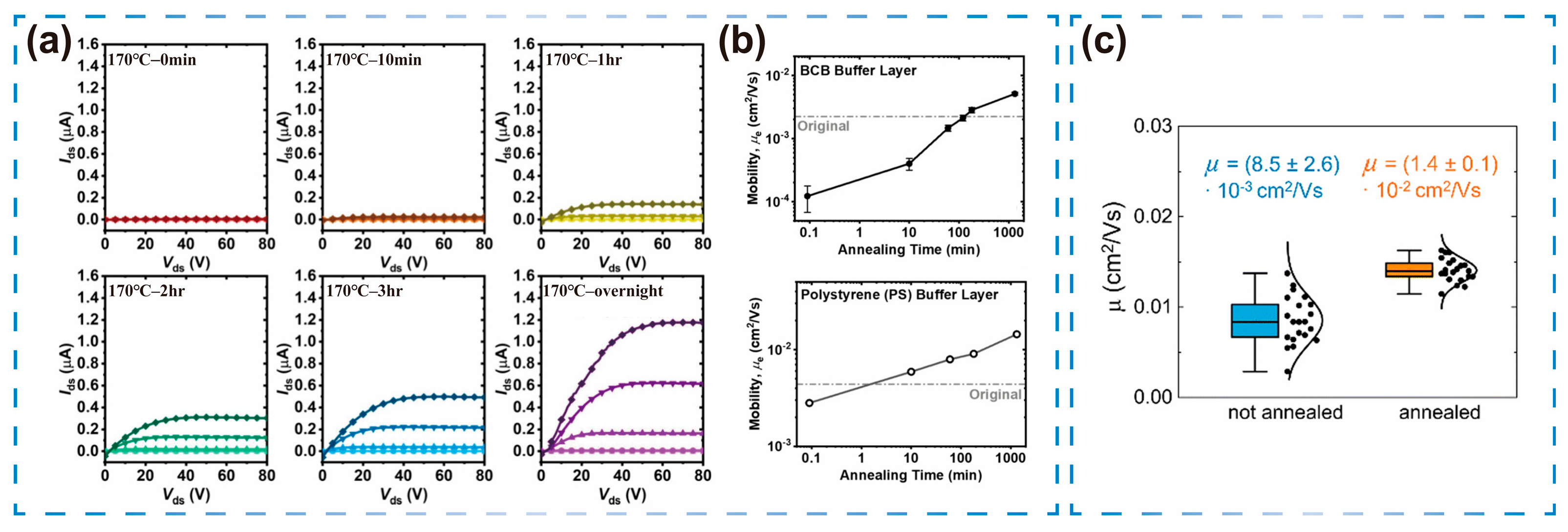
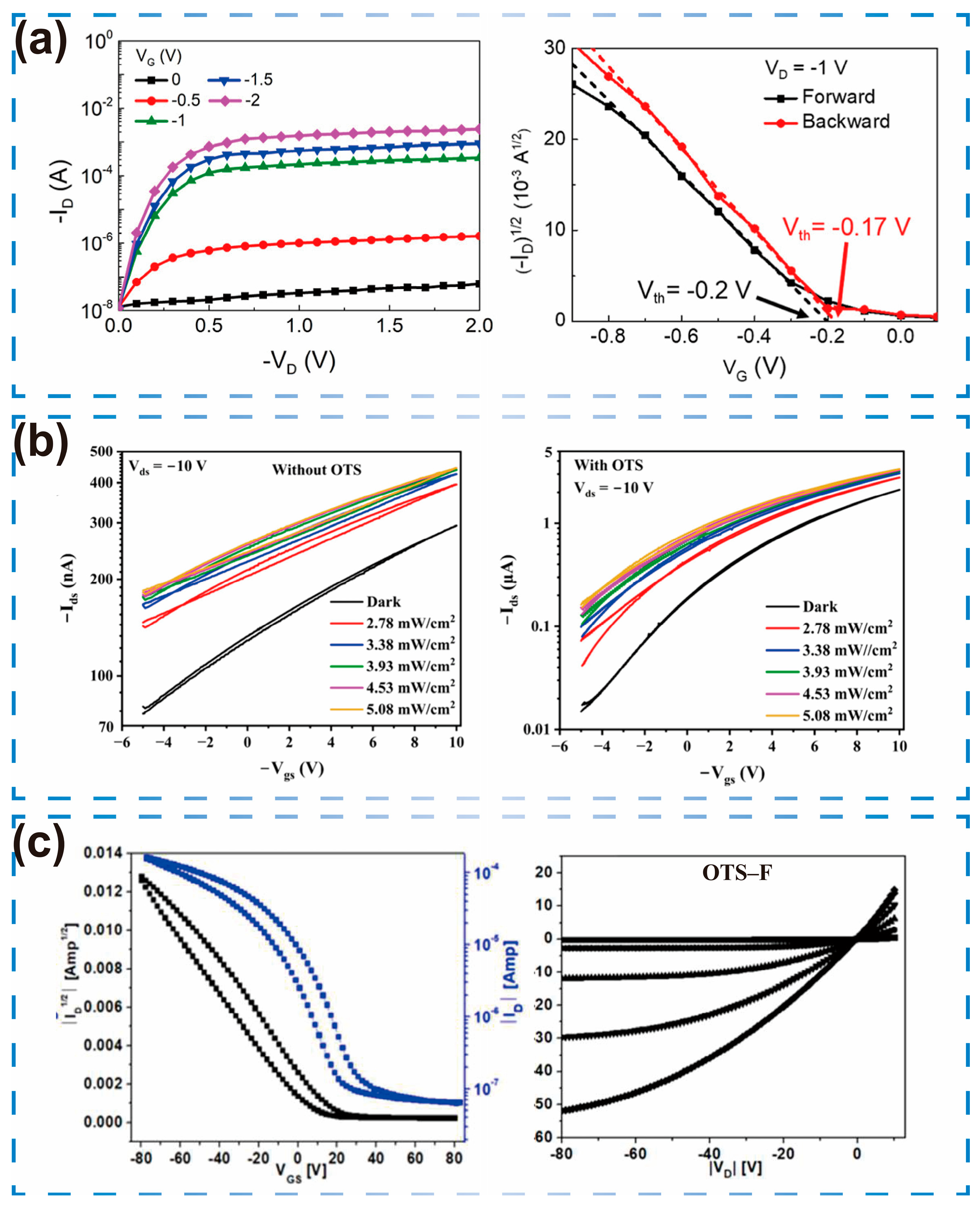

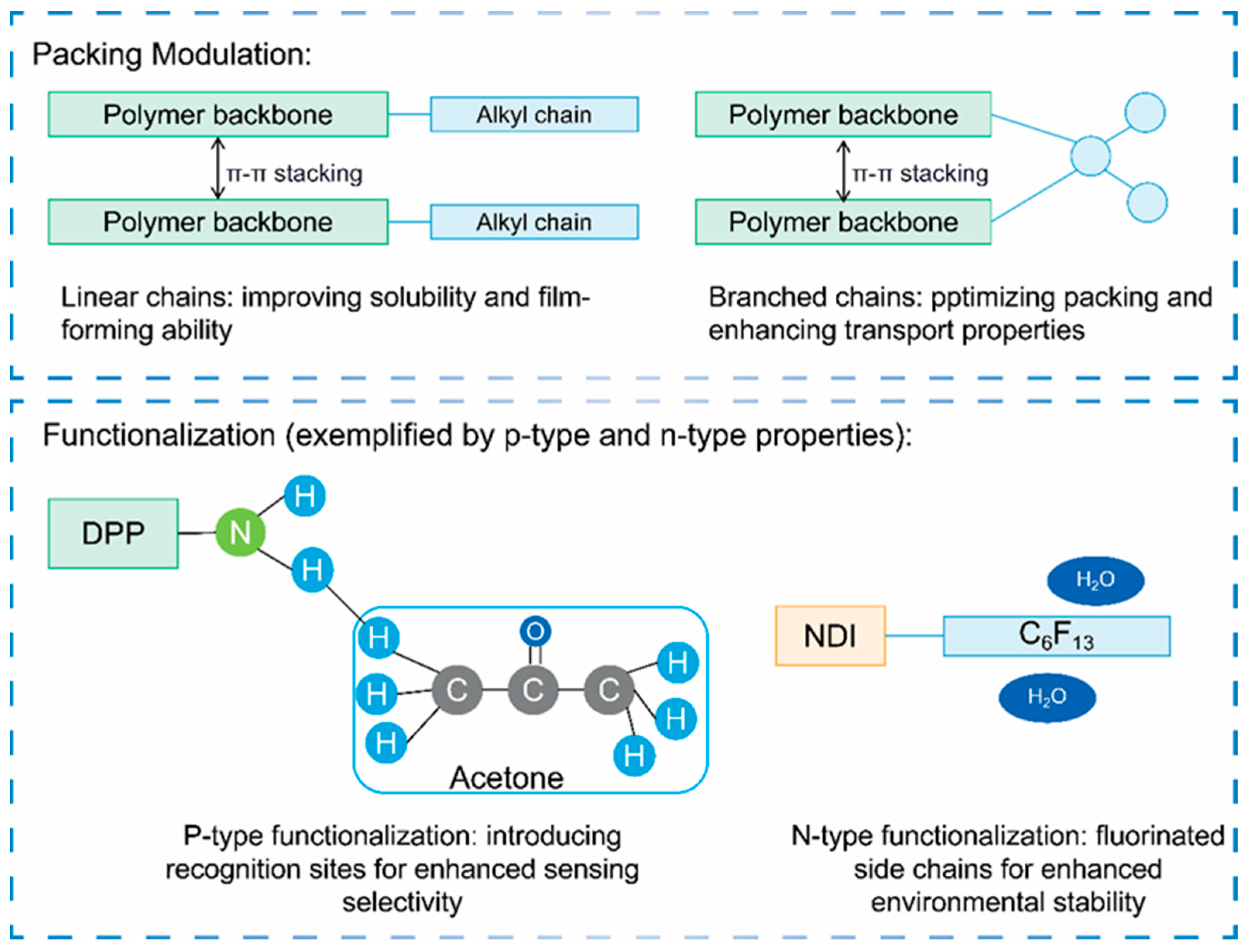

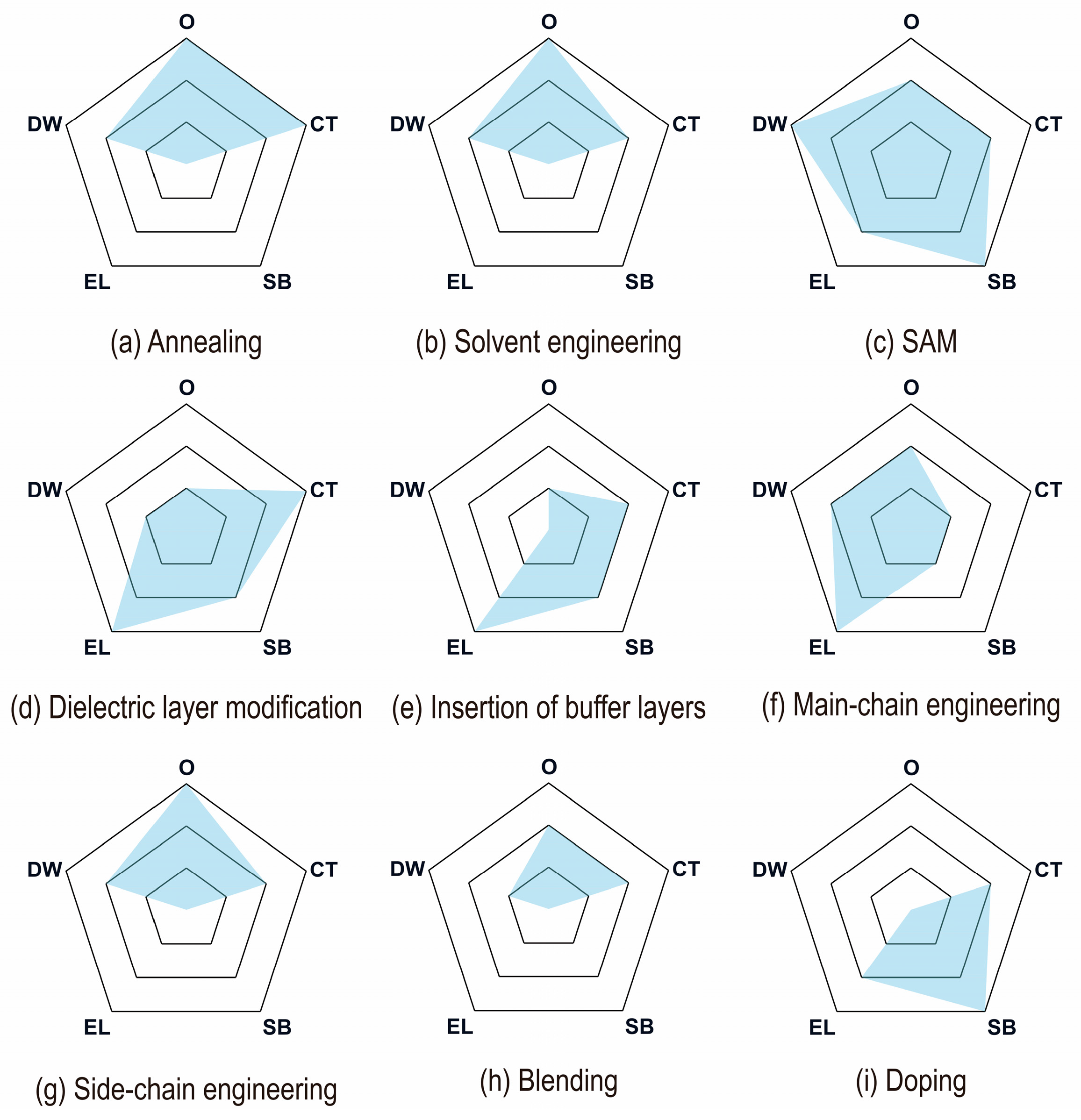

| Performance of OFET | Performance of Sensors | Impact Trend | Underlying Mechanism | Ref. |
|---|---|---|---|---|
| μ | Sensitivity | Positive correlation The higher the value of μ, the higher the sensitivity. | High mobility implies higher sensitivity of channel conductance to changes in gate or channel surface potential. | [14,15,16] |
| Response times | Negative correlation The higher the value of μ, the faster the response. | High mobility signifies faster charge carrier transport, allowing the channel current to reach a new equilibrium corresponding to the analyte concentration more quickly, thus speeding up the sensor’s response. | ||
| LOD | Negative correlation The higher the value of μ, the lower the LOD, the stronger the detection ability. | High mobility contributes to a higher signal-to-noise ratio and lower electrical noise, enabling the device to resolve minute current changes induced by very low analyte concentrations. | ||
| Vth | Sensitivity | Negative correlation The lower the value of Vth, the higher the sensitivity. | For a device exhibiting stability and an appropriate initial Vth, the Vth shift caused by external stimuli is more easily detectable. Determining the operating voltage of the device, a lower Vth value is beneficial for the stability of the sensing signal. Conversely, instability in Vth drift generates noise and consequently impairs the LOD, resulting in a wrong judgment. | [16,17,18] |
| Selectivity | The stability of Vth affects selectivity. | |||
| LOD | Positive correlation The lower the value of Vth, the lower the LOD. | |||
| Ion/Ioff | Sensitivity | Positive correlation The higher Ion/Ioff ratio, the higher the sensitivity. | A high Ion/Ioff ratio indicates a substantial range of current modulation between the “on” and “off” states. Devices exhibiting a high Ion/Ioff ratio within this extensive range are capable of generating a pronounced relative change in current with greater ease. | [17,18,19] |
| LOD | Negative correlation The higher Ion/Ioff ratio, the lower the LOD. | A high Ion/Ioff ratio typically implies extremely low off-state current, which directly results in lower signal-to-noise ratio. This enables the device to distinguish minute changes in current signals caused by analytes with extremely low concentrations, thereby reducing the LOD. | ||
| SS | Sensitivity | Negative correlation The smaller the value of SS, the higher the sensitivity. | The SS reflects the efficiency of gate voltage control over the channel current. The smaller the value, the more sensitive it is to the changes in interface charges or dipole moments caused by the analyte, which is beneficial for the detection of weak signals. | [17,18] |
| LOD | Positive correlation The smaller the value of SS, the lower the LOD. |
| Strategies | Advantages | Disadvantages/Challenges | Typical Performance Improvement |
|---|---|---|---|
| Annealing | Simple and highly versatile process. It can increase crystallinity and molecular orderliness, reduce trap states, and enhance carrier transport. | The annealing temperature and time need to be precisely controlled. An excessively high temperature may disrupt the orderliness. | μ (***) Vth (**) Ion/Ioff (**) SS (**) |
| Solvent engineering | It can preset the film morphology at the initial stage of processing, compatible with solution processing, and construct a structure with a high specific surface area. | The selection of solvents and the optimization of their ratios are complex. The challenge of process reproducibility is significant. | μ (***) Vth (**) Ion/Ioff (**) SS (*) |
| SAMs | It can precisely control the interface energy level and chemical properties, effectively suppress interface traps, reduce interface traps, and enhance carrier injection and transport. | The quality of SAMs is highly dependent on the substrate, and the process is complex and potential long-term stability issues of SAMs. | μ (**) Vth (***) Ion/Ioff (**) SS (***) |
| Dielectric layer modification | The most direct approach for achieving low-voltage operation. It can optimize interface stability, reduce the operating voltage, and reduce leakage current. | High-k materials may introduce interface scattering and process compatibility issues. | μ (**) Vth (***) Ion/Ioff (**) SS (***) |
| Insertion of buffer layers | Effectively isolates the active layer from unfavorable interfaces. It can reduce RC, improve the electrode/semiconductor interface, and enhance carrier injection. | It may involve additional processing steps, thereby augmenting the complexity and cost of the procedure. The layer thickness and material selection are sensitive. | μ (**) Vth (**) Ion/Ioff (**) SS (*) |
| Main chain engineering | It can directly modulate the energy levels and molecular packing to attain enhanced mobility and stability. Fundamentally, it adjusts the intrinsic energy levels and the material’s capacity for charge delocalization. | The synthesis process is intricate and associated with elevated costs; moreover, establishing clear correlations between structure and properties can be challenging. | μ (***) Vth (**) Ion/Ioff (**) SS (/) |
| Side chain engineering | Effectively tunes solubility and molecular packing while preserving the backbone electronic structure. | Excessively long or bulky side chains can hinder charge transport. Additionally, they may introduce disordered and complex functional groups, potentially leading to a reduction in charge carrier mobility. | μ (***) Vth (**) Ion/Ioff (**) SS (*) |
| Blending | Straightforward and low-cost approach. It combines the advantages of multiple materials to deliver complementary functionalities, thereby enhancing both performance and stability concurrently. | It may reduce the mobility, and the control of phase separation is difficult. | μ (**) Vth (**) Ion/Ioff (**) SS (*) |
| Doping | It can substantially enhance conductivity, optimize contact interfaces, regulate carrier concentration, and decrease RC. Additionally, it serves as an effective method for tuning the Vth. | Difficult to precisely control concentration and distribution. It may introduce scattering centers, resulting in poor stability (easily prone to doping loss) and lead to reduced stability and increased off-current. It need high requirements for process control. | μ (**) Vth (***) Ion/Ioff (May be reduced) SS (/) |
Disclaimer/Publisher’s Note: The statements, opinions and data contained in all publications are solely those of the individual author(s) and contributor(s) and not of MDPI and/or the editor(s). MDPI and/or the editor(s) disclaim responsibility for any injury to people or property resulting from any ideas, methods, instructions or products referred to in the content. |
© 2025 by the authors. Licensee MDPI, Basel, Switzerland. This article is an open access article distributed under the terms and conditions of the Creative Commons Attribution (CC BY) license (https://creativecommons.org/licenses/by/4.0/).
Share and Cite
Wang, Y.; Ye, Z.; Wang, T.; Zu, L.; Chen, L. Performance Optimization Strategies for Polymer Organic Field-Effect Transistors as Sensing Platforms. Sensors 2025, 25, 6891. https://doi.org/10.3390/s25226891
Wang Y, Ye Z, Wang T, Zu L, Chen L. Performance Optimization Strategies for Polymer Organic Field-Effect Transistors as Sensing Platforms. Sensors. 2025; 25(22):6891. https://doi.org/10.3390/s25226891
Chicago/Turabian StyleWang, Yan, Zimin Ye, Tianci Wang, Linxiao Zu, and Liwen Chen. 2025. "Performance Optimization Strategies for Polymer Organic Field-Effect Transistors as Sensing Platforms" Sensors 25, no. 22: 6891. https://doi.org/10.3390/s25226891
APA StyleWang, Y., Ye, Z., Wang, T., Zu, L., & Chen, L. (2025). Performance Optimization Strategies for Polymer Organic Field-Effect Transistors as Sensing Platforms. Sensors, 25(22), 6891. https://doi.org/10.3390/s25226891





